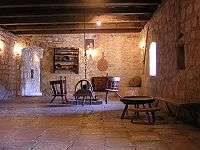Njeguši
Njeguši (Montenegrin and Serbian Cyrillic: Његуши) is a village in the Cetinje Municipality of southern Montenegro, located on the slopes of Mount Lovćen, within the Lovćen national park. The village is best known as the birthplace of the Petrović dynasty, which ruled Montenegro from 1696 to 1918, as well as the Montenegrin office of the ''serdar'' and ''guvernadur'', held by the Radonjić family. The village is also significant for its well-preserved traditional folk architecture. Njeguški sir and Njeguški pršut (local forms of cheese and prosciutto respectively), made solely in area around Njeguši, are genuine contributions to Montenegrin cuisine. The village is situated in the Njeguši field and historically used to be a center of the tribe of the same name that formed a part of Katunska Nahija, one of the provinces of Old Montenegro. The village consists of the settlements: Dugi Do, Žanjev Do, Erakovići, Kopito, Vrba, Raićevići, Velji and Mali Zalazi, Majstori and Mirac. The name Njeguši is according to Ilija Ruvarac derived from Negusius Podcupica, mentioned in an 11th-century document. The original house the Petrović Family used to live in is located at 42.432271, 18.808675.



According to the 2003 census, the village had 17 inhabitants, of whom 15 declared as Montenegrins, 1 as Serb, and 1 Unknown. According to 2011 census, there were 35 inhabitants, 33 of whom were Montenegrins, one did not want to reveal ethnicity and one was a Russian.[1]
Famous people descending from Njeguši
- House of Petrović-Njegoš
- Metropolitan Danilo I Petrović-Njegoš
- Sava II Petrović Njegoš
- Vasilije III Petrović-Njegoš
- Petar I Petrović Njegoš
- Petar II Petrović-Njegoš
- Danilo I, Prince of Montenegro
- Mirko Petrović-Njegoš
- Nicholas I of Montenegro
- Danilo, Crown Prince of Montenegro
- Prince Mirko of Montenegro
- Prince Peter of Montenegro
- Princess Zorka of Montenegro
- Princess Milica of Montenegro
- Princess Anastasia of Montenegro
- Elena of Montenegro
- Princess Anna of Montenegro
- Princess Xenia of Montenegro
- Michael, Prince of Montenegro
- Nicholas, Crown Prince of Montenegro
- Boris, Hereditary Prince of Montenegro
- Prince Milo of Montenegro
- Staniša Radonjić
- Stanislav Radonjić
- Jovan Radonjić
- Vukolaj Radonjić
- Rufim Njeguš
- Mašo Vrbica
- Mladen Kašćelan
- Predrag Kašćelan
- Vasko Ševaljević
- Momčilo Otašević
- Ljubo Ševaljević
References
- Zavod za Statistiku Crne Gore. 2011. "Popis na nivou nasejla." http://www.monstat.org/cg/page.php?id=536&pageid=322
| Wikimedia Commons has media related to Njeguši. |